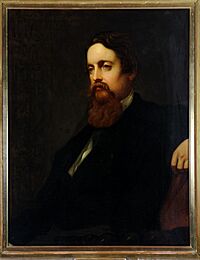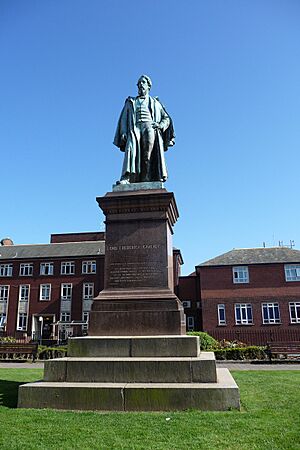Lord Frederick Cavendish facts for kids
Quick facts for kids
Lord Frederick Cavendish
|
|
|---|---|

Lord Frederick Cavendish by John D. Miller,
published 1883 (after Sir William Blake Richmond, exh. RA 1874) |
|
| Chief Secretary for Ireland | |
| In office 6 May 1882 |
|
| Monarch | Victoria |
| Prime Minister | William Ewart Gladstone |
| Preceded by | William Edward Forster |
| Succeeded by | George Trevelyan |
| Personal details | |
| Born | 30 November 1836 Compton Place, Eastbourne, Sussex, England |
| Died | 6 May 1882 (aged 45) Phoenix Park, Dublin, Ireland |
| Political party | Liberal |
| Spouse |
Hon. Lucy Lyttelton
(m. 1864) |
| Parents | |
| Relatives | George Lyttelton (father-in-law) |
| Alma mater | Trinity College, Cambridge |
Lord Frederick Charles Cavendish (born November 30, 1836 – died May 6, 1882) was an English politician. He was a member of the Liberal Party and a close helper of the Prime Minister, William Ewart Gladstone. In May 1882, Lord Frederick became the Chief Secretary for Ireland. This was a very important job. Sadly, just hours after arriving in Dublin, he was killed in an event known as the Phoenix Park Murders. This happened because of a group called the Irish National Invincibles.
Contents
Lord Frederick Cavendish: His Life Story
Early Life and Education
Lord Frederick Cavendish was born in Compton Place, Eastbourne, Sussex. His father was the 7th Duke of Devonshire, a very important noble. His mother was Lady Blanche Howard. He had a brother, the Marquess of Hartington, who also held the Chief Secretary for Ireland job later on.
Lord Frederick was taught at home when he was young. In 1855, he went to Trinity College, Cambridge, a famous university. He finished his studies there in 1858. After college, he joined a cavalry group called the Duke of Lancaster's Own Yeomanry.
His Time in Politics
From 1859 to 1864, Lord Frederick worked as a private secretary for Lord Granville, another important person. He also traveled a lot, visiting the United States and Spain.
In 1865, he was chosen to be a Member of Parliament (MP) for the Northern Division of the West Riding of Yorkshire. This meant he represented that area in the House of Commons, which is part of the UK government. He kept this job until he died.
Later, he became a private secretary to Prime Minister William Ewart Gladstone. He also held other government roles, like a junior Lord of the Treasury and then Financial Secretary to the Treasury. In May 1882, he was given the big job of Chief Secretary for Ireland.
A Tragic Day in Dublin
What Happened?
On May 6, 1882, Lord Frederick Cavendish traveled to Dublin with the 5th Earl Spencer, who was the Lord Lieutenant of Ireland. Lord Frederick officially started his new job at Dublin Castle that day.
However, later that same afternoon, a terrible event happened. While walking in Phoenix Park with Thomas Henry Burke, another important official, Lord Frederick was attacked. Members of a group called the Irish National Invincibles were responsible. This sad event became known as the Phoenix Park killings.
It was later found out that the attackers did not plan to hurt Lord Frederick. Their target was actually Mr. Burke. Lord Frederick was killed because he was with Mr. Burke at the time.
Remembering Lord Cavendish
Lord Frederick's body was brought back to England. He was buried on May 11 in the churchyard of St Peter's Church, Edensor, near Chatsworth. Many people, including 300 members of the House of Commons, came to his funeral.
Lord Frederick married Lucy Caroline Lyttelton in 1864. She was the granddaughter of Sir Stephen Glynne and the niece of Prime Minister Gladstone's wife.
There are several memorials to Lord Frederick Cavendish. A statue of him stands in Barrow-in-Furness, a town where his father had invested a lot of money in local businesses. A special window was placed in St Margaret's Church, Westminster, paid for by members of the House of Commons, to remember him. You can also see a large white marble tomb for him in Cartmel Priory. He was also a council member for Yorkshire College in Leeds, which later created a special physics teaching position in his honor. There is also a memorial fountain dedicated to him at Bolton Abbey.
Images for kids
-
The funeral of Lord Frederick Charles Cavendish in St Peter's Churchyard, Edensor.
-
This window was put in his memory in St Peter's Church, Edensor by Hardman & Co. in 1882.
-
The beautiful Carrara marble memorial inside Cartmel Priory.









